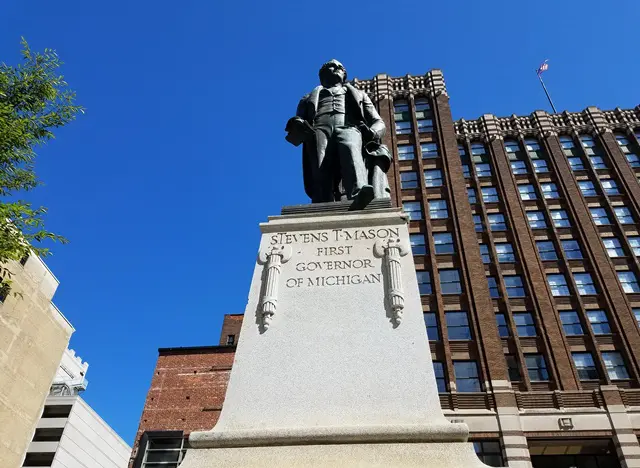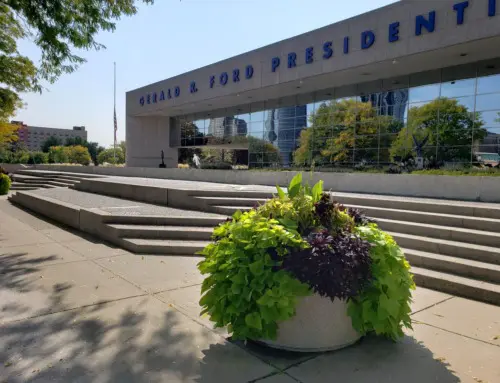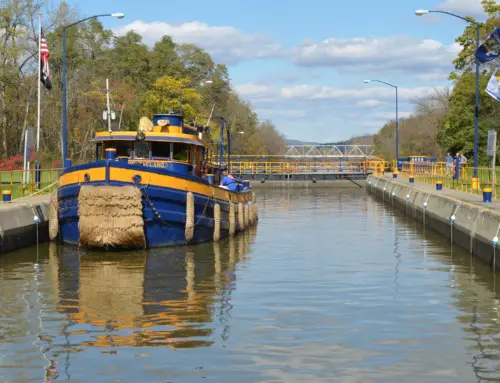This time of year often brings some heated college football rivalries, and none more nationally-known than the University of Michigan versus Ohio State University. It seems as though these two colleges, and by extension, these two states, have a deep animosity toward one another. When did this start? How did it happen? Well, readers, I have a theory, and it goes back to the 1830’s, when Michigan was trying to become a state, and the city of Toledo seemed to hold the key to economic greatness. December marks the anniversary of the ‘Frostbitten Convention’, which gave Ohio the disputed “Toledo Strip” and Michigan the Upper Peninsula and statehood.
The issue began in 1805 when Congress created the Michigan territory. The southern boundary line of the new territory was different from what Ohio had drawn up in their state constitution in 1802. The difference went unnoticed at the time, but it would later spark political controversy that would be felt nationwide.
In 1812, Congress decided to officially survey the line, but it was delayed due to the war with Great Britain. Finally in 1816, Surveyor General Edward Tiffin, a former Ohio governor, commenced the survey. Upon being hired to do the survey he was told to look at the line that had been described in the Ohio Constitution, not the line set forth by Congress in 1805, placing the mouth of the Maumee River, an important port, completely in Ohio. This, understandably, upset the people of Michigan, especially territorial governor Lewis Cass.
In response, Michigan commissioned a survey of their own and based it on the original Congressional line. The area in between the two lines, the disputed territory, became known as the “Toledo Strip”. Ohio refused to give up the land, but Michigan settlers quietly occupied it for several years, setting up local governments, collecting taxes, and making improvements to the land such as building roads.
It wasn’t just pride that caused Michigan and Ohio to hold on to the land. There was a great economic benefit to controlling that region. This was a time period before railroads were available to transport materials, so rivers and canals were the major ‘highways’ for goods to go from place to place, especially in the growing Midwest. A series of canals were being planned to connect the Great Lakes and the Mississippi River. Also during the conflict, the Erie Canal was built. This canal linked New York City to the Great Lakes making the Toledo area a major hub for corn and other Midwest products being shipped to eastern markets, which in turn made the Toledo Strip even more valuable.
The land continued to be under dispute into the 1830’s when the Michigan territory had a large enough population to apply for statehood. Michigan tried to become a state and join the Union multiple times but was being blocked by the Congressmen from Ohio. The Ohio politicians used their political power to persuade the rest of Congress to block Michigan from becoming a state until the issue of the Toledo Strip was resolved.
Then the Toledo War began. On March 31, 1835, Ohio governor Robert Lucas and 600 fully-armed militia men moved to Perrysburg, Ohio, just 10 miles southwest of Toledo, which caused Michigan governor Stevens T. Mason to occupy Toledo with 1,000 armed men. Michigan’s goal was to prevent Ohio settlers from moving into the Toledo area. This is when President Andrew Jackson intervened.
Andrew Jackson wanted to prevent an armed conflict and a political crisis, so he consulted Attorney General Benjamin Butler to make a ruling on the border dispute. Ohio was becoming a political powerhouse in the Union and Michigan was still only a territory so had no vote in Congress. Jackson’s Democratic party needed Ohio’s favor and votes for the looming 1836 Presidential election. Unfortunately for Jackson, Butler’s response would not guarantee that support from Ohio. Butler said, that until Congress dictated otherwise, the land rightfully belonged to Michigan. Problem solved, right? No, as with many things in politics, it was not quite that simple.
On April 3, 1835, Jackson sent representatives to Toledo in an attempt to try and resolve the conflict. The offer was that the residents of the Toledo Strip would be allowed to choose their own state or territorial governments until Congress could settle the matter. Ohio governor Robert Lucas reluctantly agreed and began to send his militia home, but Michigan governor Stevens Mason refused the deal and prepared for the possibility of armed conflict. Three days later, elections were held, but not before Ohio officials were harassed by pro-Michigan authorities and residents were threatened with arrest if they submitted to Ohio rule.
After the election, Lucas believed the situation was resolved in Ohio’s favor and sent out surveyors to officially mark the line. On April 26, the surveying group was attacked by fifty to sixty Michigan militiamen. This is now known as the Battle of Phillips Corners and was the only real battle of the war. The Michigan militia advised the surveyors to retreat and fired shots in the air to chase the Ohioans from what they perceived to be Michigan land. The surveyors who did not run were taken prisoner.
In early summer of 1835, Governor Lucas and the Ohio legislature set up a special court to oversee the illegal abduction and unlawful imprisonment cases against the Michigan militia. Ohio also passed several controversial acts that only fueled the people of Michigan’s anger. In addition to appropriating $315,000 (that it really didn’t have) to fund their militia, Michigan also drafted a State Constitution. Congress and President Jackson were still not willing to allow Michigan into the Union and vowed to reject statehood until the Toledo issue was resolved. The governments of both Michigan and Ohio tried to get the best of each other and many skirmishes and arrests occurred. Lawsuits were rampant and spying parties were organized to keep track of those who were entrusted with securing the border.
After months of unrest, on July 15, 1835, blood was spilled. Michigan’s Monroe County Deputy Sheriff Joseph Wood went into Toledo to arrest Major Benjamin Stickney. He and his sons, One and Two (yes, he named his sons One and Two) resisted, and the whole family was taken into custody. During the struggle, Two Stickney stabbed Deputy Wood with a pen knife, then fled south into Ohio. The deputy’s wounds were not life-threatening, but Michigan governor Mason demanded that Ohio governor Lucas extradite Stickney for a trial. Lucas refused, so Mason appealed to President Jackson, who declined to intervene.
Finally in August, Jackson caved in to Ohio congressmen and removed Mason as the Territorial Governor of Michigan. He appointed John S. Horner to take his place. Horner was very unpopular and didn’t last long. Michigan residents burned him in effigy and threw carrots at him when he entered the capitol. In the October elections, Michigan residents approved the draft of the state constitution, elected Mason as governor once again, and chose their first congressmen. However, Congress refused to accept Representative Isaac E. Crary, and the two newly elected Senators were treated with disrespect because of the dispute.
On June 15, 1836, Jackson signed a bill that finally allowed Michigan to become a state if they gave up the Toledo Strip. If they agreed, Michigan would be given a larger area of the Michigan territory, what we now call the Upper Peninsula. In September, the Michigan legislature that had gathered in Ann Arbor denied the offer because, at the time, the Upper Peninsula was considered a worthless, remote wilderness.
As the year came to a close, Michigan realized it was nearly bankrupt, partially as a result of the high militia expenses. The US Treasury was about to distribute a $400,000 surplus to the 25 existing states, but not the territories. If Michigan did not become a state, they would miss out on the funds.
On December 14, 1836, in Ann Arbor, Governor Mason called a Michigan Territorial Convention. The event was cloaked in controversy. Mason chose delegates who he knew would support statehood, and he was not upset that some of the strongest defenders of Michigan’s claim to Toledo boycotted the convention. Some Michiganders called the convention illegal. The delegates passed the resolution to accept Congress’s terms to become a state, and the Toledo War officially ended. Many Michigan residents rejected and ridiculed the resolution, and even Congress questioned the legality of the convention. Because of the chilly reception of the resolution and the notable cold spell at the time in Ann Arbor, this event became known as the Frostbitten Convention. Michigan was finally admitted to the Union as the 26th state on January 26, 1837.
The Toledo strip became a permanent part of Ohio, and the Upper Peninsula remained a part of Michigan, but it’s important to note that it wasn’t long before the creation of railroads made the Toledo Strip less important than originally believed. While it may seem as though Ohio won the Toledo War, I’d say Michigan was the real winner since we gained the rich minerals and timberland as well as the picturesque scenery that is our Upper Peninsula today. Differences of opinion about the exact border lasted until 1915 when a final survey was done. This led to one final border adjustment until 1973 (but that’s another story). So since the Toledo Strip dispute has lasted over 200 years, I think it is safe to say that the Ohio-Michigan rivalry will last for decades to come.







Leave A Comment
You must be logged in to post a comment.